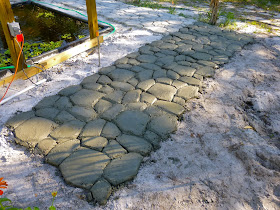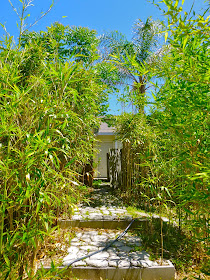Today was another pond construction day. As you can see from these images there wasn't a cloud in the sky, which doesn't necessarily make the work any easier. It was not oppressively hot but it was very bright and there was a lot of reflectance off the white sands.
These are some of my tools; an electric concrete mixer, unbreakable shovel, heavy duty wheelbarrow, trowels, and bags of concrete.
click on any images on PHILLIP'S NATURAL WORLD to enlarge
Due to the extremely low humidities the concrete did not want to mix correctly. It was either too wet or too dry. It took what seemed forever to get this project moving today. I had already spent a couple of days raising up the side of the pond about 6" after we discovered that flood waters flow through this area (through the garage and into the pond). We've had so little rain this year that the pond was already constructed when we had a 2.5-inch rainstorm last week and the runoff rushed into the pond. It is an optical illusion. It feels like the water should drain toward the back of the property into an old sinkhole (to the left).
I was fascinated with the rainbows I was creating with the spraying water. Perhaps I'd had too much sun?
Hours later I had accomplished what I set out to do for the day. I finished about 1/2 of the missing link of concrete walkway.
A close-up of today's work. There is a gentle curve in this section of walkway that will be enhanced later on with a perpendicular pathway that will lead from this pond to the next.
Another angle. The sinkhole is at the far-left-center of image. It is currently filled with leaves and branches but they will disappear (decompose) if/when the rains return.
The exposed pipe is the conduit for the electricity. I'm still reworking the back side of the pond to prevent future flood-water runoff into the pond. I started planting some of the hundreds of Caladiums (Caladium bicolor) that I've started in pots to circle this pond. They are the red in the foreground center of this image. I sink the pots of Caladiums into the ground and cover the area around them with oak leaves. Leaving the plants in pots helps them to survive our ever-more-frequent dry periods.
Another angle of the wet concrete and the cloudless sky. Temperatures were in the mid-80°s F (29° C) and there was little to no wind. There were a lot of wasps taking advantage of the moisture and mud. They use the mud to make their nests. Aside from the wasps, which didn't really bother me, it was an unusually bug-free afternoon.
I kind of liked this shot of the blazing sunset and the pond which is progressing. On the left side of the sun is a giant Live Oak (Quercus virginiana). On the right is a massive stand of giant bamboo. While I really like the giant bamboo it is very slow-growing, so I'm sticking to more modest varieties that grow to 20-30 feet but achieve that height quickly.
I'm kind of going for this feel with the gardens only without the wooden pathways. I want it to be a bamboo jungle with no grass to mow. Bamboo is both drought and cold tolerant so it should survive well in our changing climate.
This is one of the more mature pathway areas where the bamboo is filling in on both sides. We need consistent rains for the bamboo to thrive.
This is the first koi pond I constructed a couple years ago. It is finally becoming something like the image above, with thick, tall bamboo on both sides.
This is another shot of the first koi pond, at sunset. If we get a little more rain the bamboo will have a new growth spurt and will completely shade the area. I would like for the pond to only receive filtered light, which would be ideal for the fish. Currently the pond is filthy and the fish need to be moved but until the new pond is better shaded the fish will have to stay put. To keep the water sufficiently aerated to sustain the fish, I have two large pumps running 24 hours/day.
The koi are really Common Carp (Cyprinus carpio) that have been bred for their coloration and patterning. After many predator attacks over the years I only buy very cheap fry (baby fish) and hope for some nice, colorful varieties to emerge from those fry. More than half of my koi are black, grey or brown and thus not easily seen in the black pond. My koi are now protected by thick nets that detract from the ambiance of the garden but offer some protection to the fish.
Those who spend a lot more time and money on this hobby use charts like this to identify the varieties of koi. I have some Tancho, a bunch of Kawarimono, and quite a few Shusui along with lots and lots of Asagi.
Visit
and
for more photos and environmental news and analysis
For important review of Republican attempts to
dismantle the Medicare safety net for elderly and disabled Americans visit














